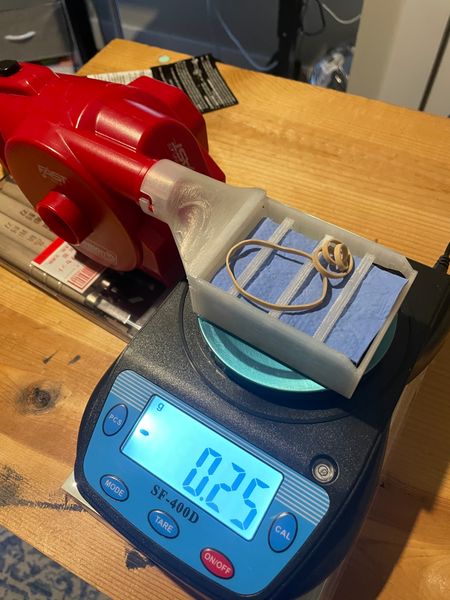🧽 Absorptive Drying
June 17, 2024
Time spent
Why reinvent the dryer?
The electric dryer is the second most energy intensive appliance in the home, just behind the air conditioning. The dryer needs to convert enough electricity into heat to start evaporating the water held in the clothing fibers, all while turning a large motor to rotate the tumbler drum, running a fan to pull the water-saturated exhaust air out, and keep the controller operating. We have heatpumps coming on to the scene that can drastically reduce the operational cost of air conditioning, albeit through a sizable upfront investment, but I haven't seen anyone talking about a similar technology breakthrough for the 2nd largest electricity suck.
My sister keeps reminding me that it is not good to dry your clothes. It degrades the material and can lead to fit issues. Of course the convenience of dry your clothes by tossing them into a big box instead of hanging each individual item is hard to pass up when you dislike doing laundry as much as I do. So while I think better energy efficiency in our lives is important, it can't be done in a way that feels like a sacrifice for the user.
When going through solutions to less damaging, more efficient methods for drying clothes I came to a realization: I hate all of these options. The proposal of adding another step in the laundry process filled me with dread and made me take a step back.
Why stop at drying?
I am aware that I am likely in the minority of people in my desire for dressing like a cartoon character (which is to say I am happy wearing the same thing every day, not that I wear bright colors and strange hats). The issue is, of course, you do still have to wash your outfit and if you hate washing your clothes, like we've established I do, you put it off for a week or two. So you have to buy multiple pairs of the same shirts and pants to rotate through and before you know it you have a drawer filled with FOUR redundant replicas of your daily outfit when one should really do the job. Ugh.
So why just fix drying? Why not the whole process? Why not build a future where people like me can have just one outfit and not stink too?
The washer is the dresser
This led a few of potential ideas, but my personal favorite is a washer/dryer concept that doubles as the place you keep your clothes. Waking up to a closet of clean clothes every morning feels like an obvious dream to me and I am livid that 1950's American-futurism pop culture didn't inspire this invention already.
The most precarious part of this idea is by far the drying step so it was the best place to start.
Experiment 1: Sponge it out
Small, confined spaces are not known for their ability to dry quickly so this problem requires a bit of creativity.
My first hypothesis was: If you use an absorptive material to pull the water out of the garment, you could quickly dry the clothes without damage or using very much energy. I would just need to figure out how to dry the absorptive material later. I ran a few quick experiments to determine how well an absorptive material could actually pull water out of a garment.
I chose polyester as the stand-in for the wet clothes. My guess is that workout gear is the ideal first set of clothes to build around because:
- its typically already moisture wicking.
- people are typically only going to wear these once between washes - meaning you need a decent number of outfits if you work out frequently.
- people care less about wearing the same style of workout shorts/shirt/etc. every day than they do about clothes for work/casual activities.
- they make sense to exclude from a laundry basket of since they carry the most smells, bacteria, and moisture of any of the used garments.
The absorptive material I chose was faux chamois cloth - only because I had it on hand and it's crazy absorbent (phd level research, I know).
I ran a few trials both pressing the fabrics together and letting them sit gently. In both scenarios, the absorption follows a logarithmic curve until the fabrics reach an equilibrium. This means the absorption approach could work if you had a large enough absorptive capacity, but that seems like a lot of material.
The other approach to trying to stay on the left-side of curve is drying the absorption media at a faster rate than it can absorb water from the polyester.
Experiment 2: Keeping a dry sponge
For this experiment I printed a quick rig to blow air over the top surface of the absorptive material.


I added water to the polyester (sandwiched under the blue chamois you see in the frame) and began recording its mass every minute.

The rate of water removal did slow down, however it was still enough to dry the 85x55mm piece of polyester completely in just 11 minutes, leading me to believe there may be some potential in this drying approach.

Next steps
I want to keep testing this approach to drying clothes and start building out the concept for a way to make workout clothes clean and ready to wear everyday without any effort.
It's important to note that I did not run a control test to see if the polyester would dry even faster without the absorptive material so that's definitely something I need to look into. I would also like to test out other materials and shapes such as wicking foams cut into heat-sink like forms to maximize the evaporative surface area.
Thanks for reading if you did - I know this was a bit different than my usual weekly project.
✌️